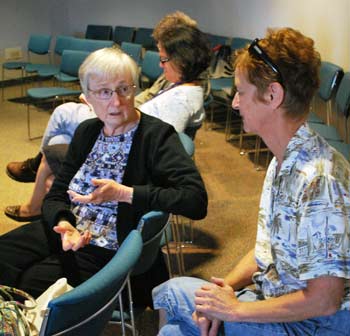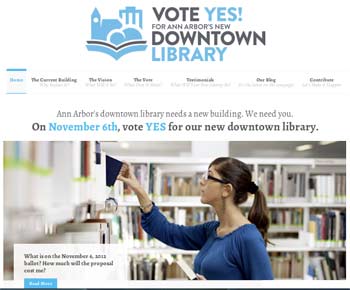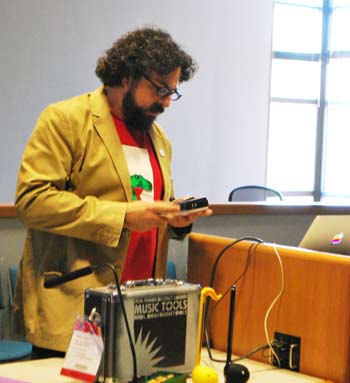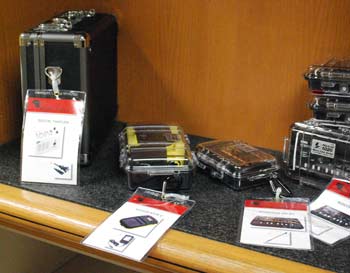AADL Board Briefed on Public Library Trends
Ann Arbor District Library board meeting (Aug. 20, 2012): With no major action items on the agenda, highlights of this week’s AADL board meeting related to the effort to build a new downtown library: (1) a presentation on trends for public libraries, including digital media and non-traditional collections, and (2) an update from the bond proposal campaign committee.

Lynn Davidge, left, talks with Sheila Rice before the start of the Aug. 20, 2012 Ann Arbor District Library board meeting. Davidge is the only non-incumbent running for a library board seat in the Nov. 6 general election. Incumbents on the ballot are Rebecca Head, Nancy Kaplan, Margaret Leary and Prue Rosenthal. (Photos by the writer.)
Ellie Serras, chair of the Our New Downtown Library campaign committee, spoke during public commentary to brief the board on actions of that group. It was formed earlier this year to support a $65 million, 30-year bond proposal that the board voted to put on the Nov. 6 ballot. Serras described the committee’s outreach efforts, including its website, Twitter account (@OurNewLibrary), Facebook group, promotional mailing, yard signs, and meetings with individuals and groups in the community.
Committee members are committed to this project and they want everyone to know how important it is, she said. ”It’s a life changer.”
In the context of the proposed building project, AADL director Josie Parker told the board that library staff are being asked about the relevancy of public libraries, so she thought it was appropriate to address that question at a formal board meeting by looking at changes that public libraries are facing. Associate director Eli Neiburger described how the library is responding to changes in the publishing industry regarding digital content. Currently, publishers are fairly restrictive in allowing public libraries to access digital content for patrons. So the Ann Arbor library has started negotiating licensing deals directly with creators – including filmmakers of the 2009 “Grown in Detroit” documentary, and the author of the graphic novel “Poopy Claws” – to allow AADL patrons to access those works through online streaming and limitless downloads, respectively.
Associate director Celeste Choate described the library’s non-media, non-traditional collections, which include art prints, energy meter readers, Science to Go kits, telescopes and electronic musical “tools.” The full list of collections is on the “Unusual Stuff to Borrow” page of AADL’s website. Additional collections are in the works, including art tools and kits for science experiments.
Though Neiburger described storage needs for digital media as trivial – he could keep 200,000 copies of “Poopy Claws” on his cell phone, if he were so inclined – the needs for non-traditional physical items are more challenging. The library’s tracking/circulation software is well-suited to adapt, because that system doesn’t care about size, he said. “But the shelf sure does.” It was an implicit reference to some of the arguments put forward in the board’s decision to pursue a new downtown building.
Also during the Aug. 20 meeting, Choate reported on a recent satisfaction survey for patrons of the Washtenaw Library for the Blind and Physically Disabled, which is operated by AADL and serves over 400 people. The library received high marks from those who responded to the survey, she said. [.pdf of survey results]
Public Commentary: Millage Campaign Update
Ellie Serras, chair of the Our New Downtown Library campaign committee, told the board that the group officially launched in July, the day after the board voted to put the bond resolution on the Nov. 6 ballot. [By way of background, other campaign committee members include Mike Allemang, (treasurer), Sally Allen, Janis Bobrin, Leah Gunn, Debbie Herbert, Norman Herbert, Pat McDonald, Paul Morel, Omari Rush, Paul Saginaw, Ingrid Sheldon and Robin Wax.]

Screenshot of Our New Library website – ournewlibrary.com – for the campaign to pass the Nov. 6 $65 million bond proposal to fund a new downtown library.
Since then, Serras said, the group has been working to get the word out, asking voters to reaffirm their investment in this community and its intellectual sustainability. They’ve developed several outreach strategies, including a website, Twitter account (@OurNewLibrary) and Facebook group. The website so far averages about 20 visits per day, but the important thing is the duration of the visits, she said – about 4 minutes, which she said means people are reading what’s on the site. They have about 100 Facebook fans and 29 Twitter followers. It’s unlikely they’ll get a large number of followers, she said, but what’s important is the quality of those followers. The majority of @OurNewLibrary’s followers themselves have between 200 to 3,000 followers each, which creates a bigger reach, she pointed out.
Last week a letter was mailed to about 1,000 voters asking for their support. Yard signs will be distributed in the next few weeks. There are ongoing meetings with individuals, businesses, and associations. Contributions to the campaign are good so far, she said, illustrating how important the library is to the community. Serras said the committee members feel privileged to work on this effort, because it’s a quality of life issue. It’s for the good of every citizen, who expects the library to be the community’s center for learning, culture and information. The committee is sharing the hard facts about the library’s critical role and relevancy, she said.
The campaign is dedicated to the people who account for the 600,000 visits to the library each year, she said, to the individuals who use the library’s computers and Internet access, who need job training, meeting space, services for the visually impaired and physically disabled – to everyone who uses the library for their own individual reasons, adding up to the common good for all, she said. Serras encouraged board members and others to learn how to use Facebook if they didn’t already know how, to get a yard sign, host a coffee, and help the campaign as much as they can. She said AADL director Josie Parker’s calendar will be filling up with meetings to talk about the bond proposal. The committee is committed to this project and they want everyone to know how important it is, she said: “It’s a life changer.”
The board and staff gave Serras a round of applause.
For additional background on the bond proposal, see Chronicle coverage: “Library Bond Moves Toward Nov. 6 Ballot” and “AADL Board: What’s Your Library Vision?” The AADL also posted a six-page fact sheet on its website with details about the proposal, and has additional information online, including a way for patrons to post comments on the library director’s blog.
Public Library Trends
AADL director Josie Parker told the board that library staff are being asked about the relevancy of public libraries, and she thought it was appropriate to address that question at a formal board meeting. The presentation was made by Eli Neiburger, AADL’s associate director of IT and product development, and Celeste Choate, AADL associate director of services, collections and access. Parker said they didn’t have time at the meeting to be comprehensive, but would touch on a couple of major points regarding the library’s collections.
Public Library Trends: Digital Content
Eli Neiburger’s talk covered some of the same ground as a presentation he’d made to the board in February 2012. He noted that the AADL currently provides access to eBooks through a proprietary service called Overdrive, which allows the library to buy temporary licenses for eBooks that can then be used one at a time by patrons. There are certain technical requirements to use Overdrive, he said, and a lot of people don’t make it through that process of updating software and making other modification before they can use the service.

Eli Neiburger, AADL’s associate director of IT and product development, preps for his presentation on digital publishing trends for public libraries.
In general, the publishing industry wants a distribution method to guarantee that its electronic offerings won’t be widely distributed among users without payment. That’s counter to how computers work – with the ability to easily share files – so libraries are experimenting with other approaches, Neiburger said.
The challenge is to develop licensing models that embrace and deliver on the potential of digital media, as opposed to using technology to emulate how physical objects are bought and circulated. People are accustomed to the immediacy of buying an eBook, so it’s frustrating when they’re told there’s a waiting list to download an eBook from the library. That’s not a good situation, he said.
Neiburger described a matrix to illustrate the current options and potential future of digital media and publishing in relation to public libraries. The X axis showed a range of market types – from closed markets like Overdrive on one end, to open markets like eBay and the Internet on the other. The Y axis ranged from the publishing industry dying back on one end, to a thriving industry on the other. He noted that it’s unlikely publishing would die off completely, likening it to candles that were once critical as a light source but that now are used primarily for ritual or ambiance.
Neiburger described four quadrants of possibilities along these axes.
- DRM (Digital Rights Management) Dystopia (Closed markets/publishing thrives): Publishers keep tight control over content, prices stay high, publishing deals are handled through intermediaries, and there are fights over what can be offered exclusively on certain devices used for reading the digital content. In this scenario, libraries take what they can get. They’d pay more for less content, and would need to find a way to offer supplemental value.
- Platform Wars (Closed markets/publishing “dies back”): Companies like Apple and Amazon lock up rights to digital content, there’s a huge range of quality, and content creators can sign exclusivity deals for their work to be distributed only over certain devices. There would be little interest in working with public libraries, so libraries would have to find a new way, such as focusing on creating new content or historical archives.
- Neo Renaissance (Open markets/publishing thrives): This scenario would be good for libraries, Neiburger said. Price points would be low, devices would be irrelevant, and libraries could buy digital content. Their infrastructure needs would be tied to storing and distributing that content.
- Free Culture Society (Open markets/publishing “dies back”): The dominant price would be free, devices would be irrelevant, publishing deals would no longer be the model, and the role of libraries would be to store and distribute content. That role would drive a library’s infrastructure needs.
Neiburger then gave some examples of how AADL is experimenting with licensing for digital content. One of its first attempts was by striking an agreement with Magnatune, a digital music publisher. In early 2011, AADL negotiated a deal with the firm for about 12,000 songs – or the equivalent of about 1,200 albums. The library bought a license for each of its cardholders at $15 per cardholder – about $10,000 annually – so that anyone can download tracks with no waiting. Magnatune’s standard charge for the service to individuals would be $15 a month. It’s akin to annual subscriptions for databases, paying a flat fee for unlimited use. Though Magnatune doesn’t offer current “hot” performers, it provides a broad collection with a wide variety of genres, including classical, world music blues, hip hop, and alt rock.
Since launching Magnatune in April of 2011, there have been about 62,500 downloads by AADL patrons, Neiburger reported. That works out to a cost per use of about 25 cents per track. He noted that as a rule of thumb for public libraries, anything less than $1 per use is considered a good deal.
Another example of AADL’s alternative approach to licensing digital content is the 2009 “Grown in Detroit” documentary, produced by Dutch filmmakers. The DVD cost $175 and at one point the library had a wait list of 60 people. So AADL approached the film’s creators, who were willing to negotiate a deal to allow library patrons to view the documentary through online streaming video. The library paid a flat fee, and anyone with an AADL card can view it. Since May of 2012, about 300 people have viewed it, Neiburger said – many more than would have had access to a DVD version.
The final example is an eBook version of the graphic novel “Poopy Claws,” about a boy and his cat, Stinky, who doesn’t use the litter box. The library negotiated a digital content license for four years, at a price set by the author for unlimited downloads by AADL patrons – $400.
Neiburger said the next target is audio books. In general, creators know that distributing their work doesn’t erode, but rather builds, their audience, he noted. For “Poopy Claws,” people who read it online might then want to buy the physical copy, or other items like T-shirts, for example.
Nancy Kaplan asked whether the library had enough space to accommodate its needs for digital content. Neiburger said the storage space that’s needed is trivial – he could keep 200,000 copies of “Poopy Claws” on his cell phone. Digital space is extremely compact, he added, and the cost of adding a file is negligible.
Jan Barney Newman asked how much Magnatune paid the musicians who are part of their collection. Neiburger said the company pays musicians 50% of the revenues it receives based on usage.
Segueing to the next part of the presentation, Neiburger noted that the library has built a very efficient system for circulating its traditional collection of materials. But circulation, shelving and building design are set up to house and circulate objects of a certain size. As that changes, one challenge is where and how to store non-traditional collections. The library’s tracking/circulation software is well-suited for it, because that system doesn’t care about size, he said, “but the shelf sure does.”
Public Library Trends: Non-Traditional Collections
Celeste Choate – AADL associate director of services, collections and access – talked to the board about the library’s non-media, non-traditional collections. She had given a briefing on that same topic at the board’s Jan. 16, 2012 meeting.
The collections include art prints; meter readers to gauge the energy efficiency of home appliances and electronics,; and Science to Go kits that focus on specific themes – prehistoric mammals, for example. The Science to Go kits contain materials that include books, DVDs, Fandex educational cards, and objects like a replica of a fossilized wooly mammoth molar. The full list of collections is on the “Unusual Stuff to Borrow” page of AADL’s website.
Earlier this year, the library began circulating telescopes, Choate said, in partnership with the University Lowbrow Astronomers. There are seven telescopes now, but because of their popularity, the library has ordered 15 more. So far there have been no problems with the items being broken or not returned, she said.
The most recent collection is electronic musical “tools” – 22 different types are available, including a concertina, Hapi drum, and theremin. Right now, Choate said, this collection doesn’t allow holds or renewals. The items are displayed next to the circulation desk of the downtown library, where patrons can see what’s available. Eventually, the collection will be rolled out to other branches.
They’ve been circulating for about three weeks, and have been well received, Choate said – one patron who’s a musician used a tool on one of his recordings. The aim was to buy items that would stand up well over time, and that weren’t available elsewhere.
Some of the items were passed out to board members, and Eli Neiburger demonstrated how they worked. Josie Parker added that they could be toys, but they’re not. Her son recently returned from Scotland and was determined to learn the bagpipes, she said. So she checked out a set of macpipes for him, which are used by professional bagpipers to practice fingering.
Barbara Murphy wondered if there are plans for more traditional musical instruments. Neiburger said the Hapi drum is a bit like a steel drum, but in general the idea is to offer instruments that local businesses don’t provide, so that the library isn’t competing.
Choate reported that two other collections are in the works: (1) art tools, like a mural projector or yarn ball winder; and (2) science tools, as a complement to the Science to Go kits, which would allow parents and kids to conduct science experiments. She said the library is open to suggestions for other collections as well.
Update: Library for the Blind & Physically Disabled
Celeste Choate also gave the board an update on a recent satisfaction survey for patrons of the Washtenaw Library for the Blind and Physically Disabled, which is operated by AADL. Such a survey is required by the National Library Service to be conducted every three years, and is very labor intensive, she said. Staff called or contacted in other ways every patron, to be sure they’re getting the service they want.
Of the WLBPD’s 446 active patrons, 37% (137 people) responded to the survey, which is a high response rate, Choate said. The responses were received by mail, email, or through talking with library staff. Of the respondents, 87% rated their experience as either excellent or good, and 97% would recommend the services to friends or family members. [.pdf of survey results]
Choate described the results as really great news, and thanked the staff for their work – specifically, outreach and neighborhood services manager Terry Soave, and library technicians Tonia Bickford and Katie Chynoweth.
Finance Report
Ken Nieman, AADL associate director of finance, HR and operations, gave a very brief financial update to the board. [.pdf of financial report] He noted that the three line items currently over budget are expected to come back in line. Those items are: employment costs (because merit increases were paid in July); communications (for an annual internet fee paid in July); and library programming/grant expenses (large purchases for the summer reading program were made in July).
He joked about having to follow the public commentary by Ellie Serras, who had received applause from the board. Jan Barney Newman said they’d applaud him too – and they did.
Present: Rebecca Head, Nancy Kaplan, Margaret Leary, Barbara Murphy, Jan Barney Newman, Prue Rosenthal, Ed Surovell. Also AADL director Josie Parker.
Next meeting: Monday, Sept. 24 at 7 p.m. in the fourth-floor conference room of the downtown library, 343 S. Fifth Ave. [Check Chronicle event listing to confirm date]
The Chronicle relies in part on regular voluntary subscriptions to support our coverage of public bodies like the Ann Arbor District Library board. Check out this link for details: Subscribe to The Chronicle. And if you’re already supporting us, please encourage your friends, neighbors and colleagues to help support The Chronicle, too!





> The library bought a license for each of its cardholders at $15 per cardholder – about $10,000 annually – so that anyone can download tracks with no waiting.
Those numbers don’t add up – it’s probably 15 cents, not 15 dollars.
The squanderites who want to keep the library church funded while its diety dies claim that the terminal banks provide a useful public service. People lacking money or skill for a home connection can get on line, do email, search for jobs, etc. Also helps those whose system is on the fritz and passers through.
No doubt some of this happens but a lot of the business is people after sex and pornography. If you walk around the terminal areas downtown at a busy time this is more than obvious. The S&P gang is mostly men who have connection at home and work. They come to the library so others don’t see what they are doing. They are not a pretty bunch, sometimes one hand is on the mouse, the other in the pants.
There is a sign by the desk that asks for consideration in viewing material that others may find offensive but no one does any enforcing. The browser has a filter that takes two clicks and three seconds to turn off. If you mention this activity to library staff they sigh and say well it is regrettable but only mirrors what happen on the internet in general right? That is true enough. However people who do S&P at home are paying for their own device, connection, electricity. At the library the taxpayers provide these things. Why?
If you haven’t checked out one of the new musical instruments, you should next time you are at the downtown library. After some fiddling around with it, my 2d grader turned a Monotron Delay into a very convincing siren to go with one of his lego creations.